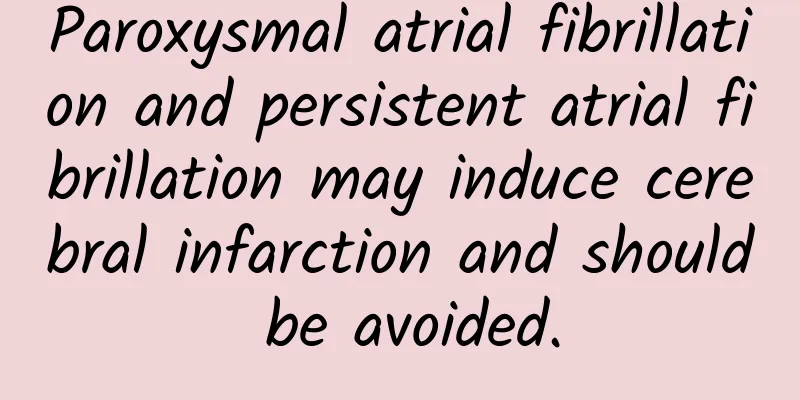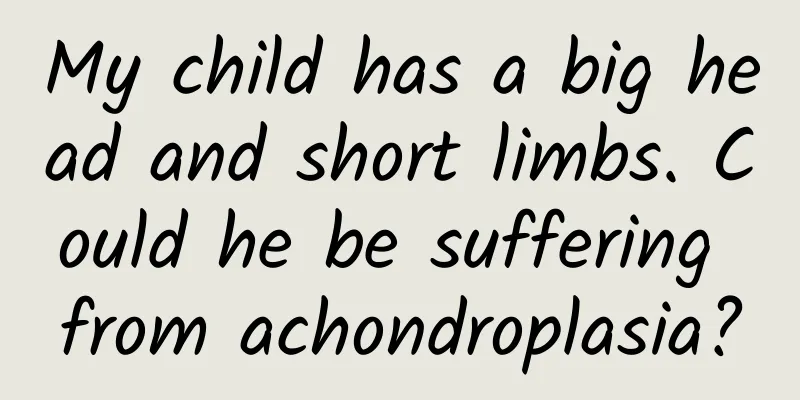Paroxysmal atrial fibrillation and persistent atrial fibrillation may induce cerebral infarction and should be avoided.

|
A friend told Huazi that he had atrial fibrillation, but it was not continuous and only occurred every few days. Was it not dangerous? Huazi said that paroxysmal atrial fibrillation could also induce cerebral infarction and should not be taken lightly. Many patients with cerebral infarction found the cause after the onset of the disease and the final result was thrombosis induced by paroxysmal atrial fibrillation. Because paroxysmal atrial fibrillation is more hidden, most of the symptoms are occasional and transient palpitations, which are easily ignored and not treated in time, and are actually more dangerous. 1. Why does atrial fibrillation occur? The human heart is divided into four parts: the left atrium, the right atrium, the left ventricle, and the right ventricle. The heart contraction signal is generated by the sinoatrial node, first transmitted to the atrium, and then transmitted to the ventricle through the atrioventricular node. In other words, the atrium and ventricle contract asynchronously. The atrium must contract before the ventricle, and blood must flow from the atrium to the ventricle to ensure the normal pumping function of the heart. Under the influence of various factors such as hypertension, coronary heart disease, rheumatic heart disease, cor pulmonale, cardiomyopathy, hyperthyroidism, alcoholism, emotional excitement, excessive exercise, etc., the atrial electrical signals become disordered, causing the atria to lose regular contraction and experience irregular contractions of 350 to 600 times per minute. 2. The dangers of atrial fibrillation When atrial fibrillation occurs, the typical symptoms are palpitations and panic, and you can feel your heart beating wildly. At this time, the atrium loses its normal function of pumping blood into the ventricle, and the blood supply to the heart will be reduced by more than 25%. For those with heart dysfunction, atrial fibrillation can easily induce heart failure. During atrial fibrillation, the blood flow in the left atrium slows down, and turbulence is likely to occur in the atrial appendage, breeding blood clots that attach to the atrial wall, known as "mural thrombi". Once the mural thrombi fall off, there is a high probability that they will enter the cerebral arteries, block the smaller cerebral arteries, and cause cerebral infarction. About 20% of cerebral infarctions are caused by atrial fibrillation. Long-term atrial fibrillation causes a decrease in the heart's blood supply, causing brain cells to be in a state of ischemia and hypoxia for a long time, which can increase the risk of dementia by 2 times. What to do when atrial fibrillation occurs Atrial fibrillation can be divided into paroxysmal atrial fibrillation and persistent atrial fibrillation. Paroxysmal atrial fibrillation is an intermittent attack, which usually terminates on its own after a short attack and turns into normal sinus rhythm, and lasts no longer than 7 days. However, persistent atrial fibrillation lasts for more than 7 days and is difficult to terminate on its own without intervention. Whether it is paroxysmal atrial fibrillation or persistent atrial fibrillation, it may induce heart failure or cerebral infarction, so you must be careful. At present, the treatment of atrial fibrillation is to control the primary disease first, and then choose drug therapy, electrical stimulation, ablation and other methods according to the specific situation to eliminate atrial fibrillation and convert it to normal rhythm. Drug treatment usually requires long-term persistence, and atrial fibrillation is prone to relapse after discontinuation of the drug; the recurrence rate of electrical stimulation is also high; only ablation has a low recurrence rate and may be able to cure atrial fibrillation, but ablation is expensive and has certain risks, and is not suitable for all patients with atrial fibrillation. If the above methods still cannot completely eliminate atrial fibrillation, you will need to coexist with atrial fibrillation for a long time and undergo long-term anticoagulant treatment. When using drugs such as warfarin and rivaroxaban that use anticoagulant factors, coagulation indicators need to be monitored during medication. If there are contraindications to medication, left atrial appendage occlusion can be performed to reduce the risk of cerebral infarction. In summary, whether it is short-term paroxysmal atrial fibrillation or persistent atrial fibrillation, it may cause complications such as cerebral infarction and heart failure, and should not be taken lightly. If atrial fibrillation is found, active intervention must be made. Ask an experienced cardiologist to diagnose and treat, and develop a surgical or drug treatment plan. Drugs for the treatment of atrial fibrillation must be used under the guidance of a doctor. If you have any questions about the use of drugs, please consult a doctor or pharmacist. I am pharmacist Huazi, welcome to follow me and share more health knowledge. |
<<: Ding~ Please check out a guide to children’s orthodontics!
>>: Can eating fish eyes throughout childhood really prevent myopia?
Recommend
How many months of pregnancy do you get stretch marks?
It is human nature to love beauty. Whether pregna...
I have a lump on my lower body that is painful and itchy
The female private parts are very sensitive and f...
How to accurately determine the ovulation day
Nowadays, the menstrual periods of many women are...
What can I eat to replenish blood after my period is over?
Menstruation is a normal physiological phenomenon...
Oral ulcers that never get better may be a warning sign of a serious illness! These "folk remedies" are useless!
If we talk about minor illnesses that are not fat...
Is it normal for the vaginal discharge to be a little yellow but without any odor?
I believe that many women have encountered simila...
Polyps in the vagina
If you find polyps in your vagina during a gyneco...
Can I eat breakfast on the day of transplant?
In recent years, there have been a lot of transpl...
The urgency and necessity of stroke prevention and treatment
Stroke is the leading cause of death in my countr...
Nano negative ion sanitary napkin
I believe many female friends know that there are...
Can diabetics drink yogurt?
Can diabetics drink yogurt? That is not the case....
Are there any symptoms after having sex for five days?
Pregnant couples are very concerned about the ovu...
After 40, try to slow down your body aging
Generally speaking, the health of a normal person...
Older "straight men" have no friends, this is a serious study
In 2014, Emma Watson launched a campaign called &...









